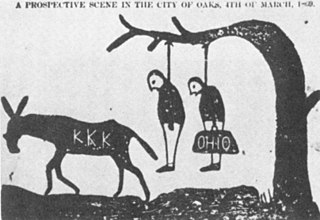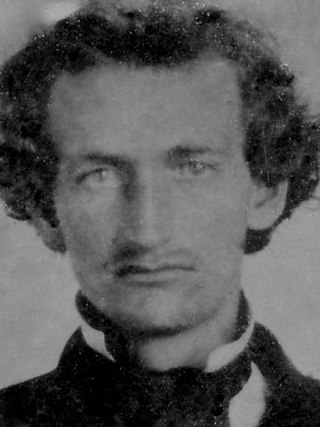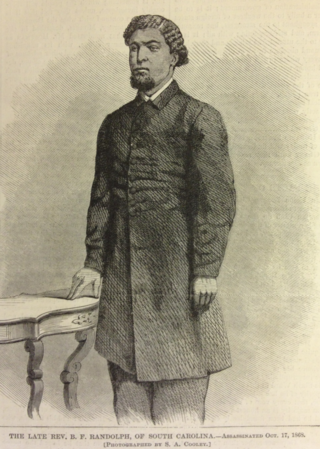Related Research Articles

The Reconstruction era was a period in American history following the American Civil War (1861–1865) and lasting until approximately the Compromise of 1877. During Reconstruction, attempts were made to rebuild the country after the bloody Civil War, bring the former Confederate states back into the United States, and to counteract the political, social, and economic legacies of slavery.

In United States history, the term scalawag referred to white Southerners who supported Reconstruction policies and efforts after the conclusion of the American Civil War.

James M. Hinds was the first U.S. Congressman assassinated in office. He served as member of the United States House of Representatives for Arkansas from June 24, 1868 until his assassination by the Ku Klux Klan. Hinds—an advocate of civil rights for former slaves—was active during the Reconstruction era following the Civil War.

The 1876 South Carolina gubernatorial election was held on November 7, 1876 to select the governor of the state of South Carolina. The election campaign was a referendum on the Radical Republican-led state government and their Reconstruction policies. Opponents disputed the challenger Wade Hampton III's victory, gained by a margin of little more than 1100 votes statewide. But he took office in April 1877, after President Hayes withdrew federal troops as a result of a national Democratic compromise, and the incumbent Daniel Henry Chamberlain left the state.
James Henry Harris (1832–1891) was an American civil rights advocate, upholsterer, and politician. Born into slavery, he was freed as a young adult and worked as a carpenter's apprentice and worker before he went to Oberlin College in Ohio. For a time, he lived in Chatham, Ontario, where he was a member of the Chatham Vigilance Committee that aimed to prevent blacks being transported out of Canada and sold as slaves in the United States.
The civil rights movement (1865–1896) aimed to eliminate racial discrimination against African Americans, improve their educational and employment opportunities, and establish their electoral power, just after the abolition of slavery in the United States. The period from 1865 to 1895 saw a tremendous change in the fortunes of the black community following the elimination of slavery in the South.

The lily-white movement was an anti-black political movement within the Republican Party in the United States in the late 19th and early 20th centuries. It was a response to the political and socioeconomic gains made by African-Americans following the Civil War and the Thirteenth Amendment to the Constitution, which eliminated slavery "except as punishment for a crime".

Prince R. Rivers (1824–1887) was a former enslaved man from South Carolina who served as a soldier in the Union Army and as a state politician during the Reconstruction era. He escaped and joined Union lines, becoming a sergeant in the 1st South Carolina Volunteers, a Union regiment in the American Civil War.

Benjamin Franklin Randolph was an American educator, spiritual advisor, newspaper editor who served as a South Carolina state senator during the Reconstruction Era. Randolph was selected to be one of the first African American Electors in the United States at the 1868 Republican National Convention for the Ulysses Grant Republican presidential ticket. Randolph also served as the chair of the state Republican Party Central Committee. He was a delegate to the 1868 South Carolina Constitutional Convention, where he played an important role in establishing the first universal public education system in the state, and in granting for the first time the right to vote to black men and non-property owning European-American men. On October 16, 1868, Randolph was assassinated by members of the Ku Klux Klan.

The Virginia Constitutional Convention of 1868, was an assembly of delegates elected by the voters to establish the fundamental law of Virginia following the American Civil War and the Fourteenth Amendment to the US Constitution. The Convention, which met from December 3, 1867 until April 17, 1868, set the stage for enfranchising freedmen, Virginia's readmission to Congress and an end to Congressional Reconstruction.

Willis Augustus Hodges was an African-American abolitionist, journalist, and political organizer who became prominent in Brooklyn, New York. Born to free parents in Virginia, Hodges became an outspoken advocate for enslaved African Americans during the Antebellum period, giving aid to the Underground Railroad in the North after a move to New York, and collaborating with such notable figures as William Lloyd Garrison, John Brown and Frederick Douglass. He also published an antislavery newspaper, The Ram’s Horn.

The North Carolina General Assembly of 1868–1869 met in Raleigh from November 16, 1868 to April 12, 1869 with a special session from July 1, 1868 to August 24, 1868. This was the first assembly to meet after the approval of the new Constitution of North Carolina in 1868. As prescribed in this constitution, the assembly consisted of the 120 members in the North Carolina House of Representatives and 43 senators in the North Carolina Senate elected by the voters on August 6, 1868. This assembly was in control of the Republican Party and was dominated by reconstruction era politics.
William Fabriel Myers was a lawyer and state senator in South Carolina. An African American, he was involved in politics during the Reconstruction Era. He served as a state senator from 1874 until 1878.

Barney Burton was a legislator in South Carolina. He served in the South Carolina House of Representatives in 1868 and 1870. He represented Chester County, South Carolina.
Henry L. Shrewsbury was an American teacher and Reconstruction era state legislator in South Carolina. He was described as a free mullato, and represented Chesterfield County in the South Carolina House of Representatives from 1868 until 1870.
William M. Thomas was an African-American Republican politician during the Reconstruction era. He was a minister affiliated with the African Methodist Episcopal Church. He represented Colleton County in the 1868 South Carolina Constitutional Convention and in the South Carolina House of Representatives from 1868 until 1876. He was also an officer in the state militia and was a delegate to the 1876 Republican National Convention. He was categorized as "colored". He and Joseph D. Boston were the only African Americans to serve all four terms during the Reconstruction era in the South Carolina House.
Reconstruction in the state of South Carolina was unique compared to other southern states due to heavy political involvement of both] and newly freed African American slaves.
John Carraway was a tailor, seaman, civil rights activist, and politician in the United States. In Alabama during the Reconstruction era, he served as a delegate to the 1867 Alabama Constitutional Convention. He also served on Mobile, Alabama's city council, and in the Alabama House of Representatives.
Frederick Albert Clinton was a delegate to the 1868 South Carolina Constitutional Convention, state legislator, trial justice, and militia officer. He represented Lancaster County, South Carolina in the South Carolina Senate from 1868 to 1877. He was a Republican.

William E. Johnston (1838-1899) was a state legislator who served during the Reconstruction era in the South Carolina House of Representatives from 1868 to 1869 and the South Carolina State Senate from 1869 to 1877.
References
- ↑ "Index to Politicians: Vincente to Vlodeck". The Political Graveyard. Retrieved 2021-11-05.
Viney, W. M. — of Colleton County, S.C. Delegate to South Carolina state constitutional convention from Colleton County, 1868. African ancestry. Burial location unknown.
{{cite web}}: CS1 maint: url-status (link) - 1 2 Foner, Eric (1996). Freedom's Lawmakers: A Directory of Black Officeholders During Reconstruction. Louisiana State University Press. p. 219. ISBN 9780807120828.
- 1 2 3 Holt, Thomas (1979). Black Over White: Negro Political Leadership in South Carolina During Reconstruction. University of Illinois Press. p. 79. ISBN 978-0-252-00775-0.
- 1 2 3 4 Saville, Julie (1996-04-26). The Work of Reconstruction: From Slave to Wage Laborer in South Carolina 1860-1870. Cambridge University Press. p. 162. ISBN 978-0-521-56625-4.
- ↑ The South Carolina Historical Magazine, Volumes 85-86. South Carolina Historical Society. 1984. pp. 248–249.
- ↑ Representatives, USA House of (October 31, 1868). "House Documents". U.S. Government Printing Office – via Google Books.
- ↑ "The Political Graveyard: South Carolina: 1868 Constitutional Convention". politicalgraveyard.com.